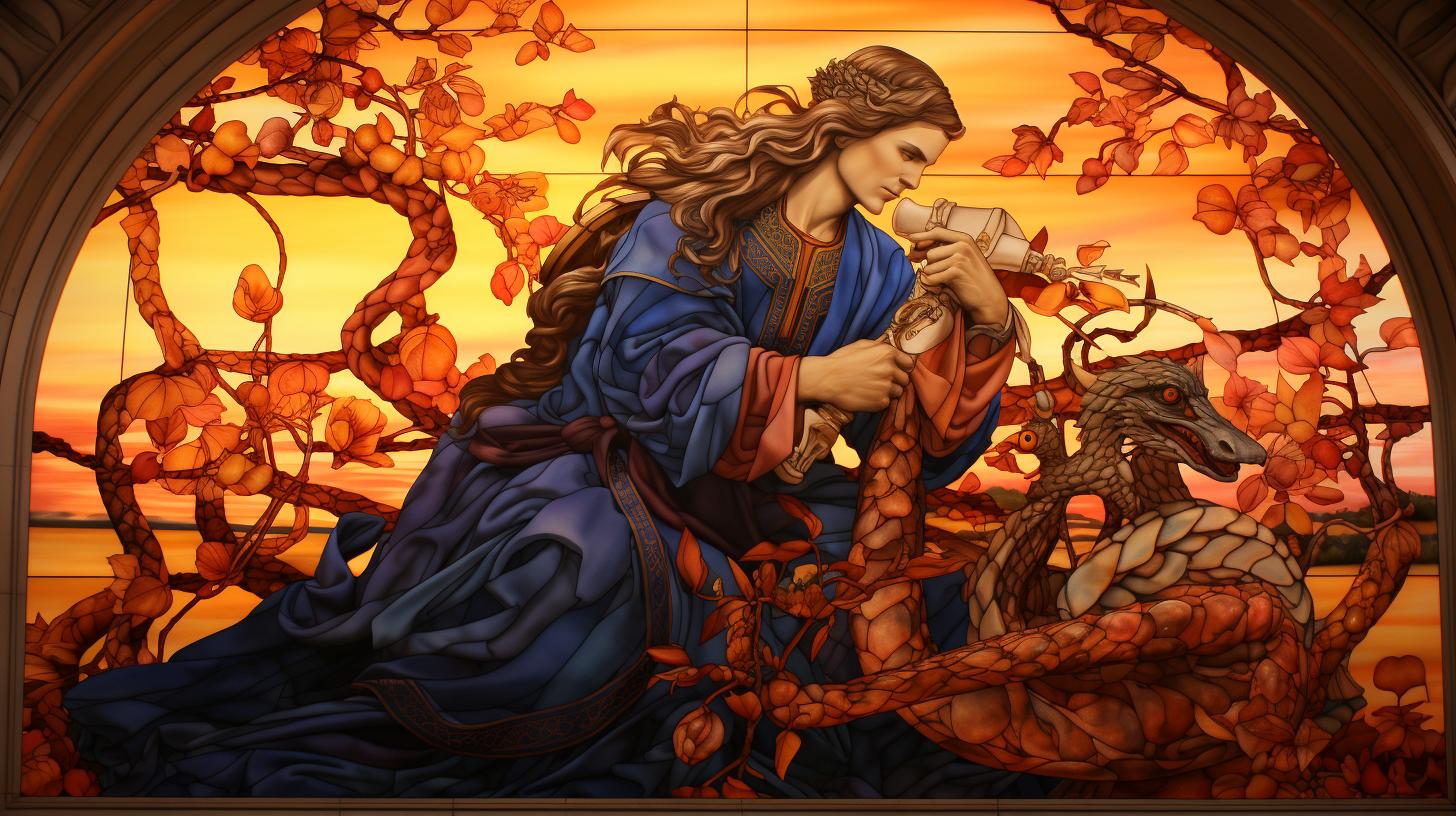Goddess Libera: Unveiling Ancient Roman Fertility and Freedom

Libera goddess holds a significant place in ancient Roman mythology and religious practices. She is associated with fertility, possibly wine, and is believed to be the daughter of Ceres. Libera shares a temple with Ceres and Liber, her husband identified with Dionysius and Bacchus. Proserpina, queen of the underworld, is closely connected to Libera and Ceres. In this article, we explore the mythology and worship of Libera, her relationship with Proserpina, and the contrasting presence of Liber Pater.
Additionally, we delve into related deities such as Libitina and Naenia.
The Mythology of Libera Goddess
Discover the captivating mythology behind Libera, a prominent figure in ancient Roman religion and folklore.
Origins of Libera
The origins of Libera can be traced back to Italian and Roman mythology, where she is revered as a goddess of fertility, vegetation, and possibly wine. She holds a significant place within the pantheon, sharing a temple with Ceres and Liber.
As the daughter of Ceres, Libera embodies the bountiful abundance of nature.
The Divine Family: Libera, Ceres, and Liber
Within the divine family, Libera’s connection with her mother, Ceres, is of utmost importance. Ceres, the goddess of agriculture and grain, contributes toLibera’s association with fertility and agricultural abundance.
Liber, Libera’s husband, is identified with Dionysius and Bacchus, representing the masculine fertility and freedom associated with pleasure.
Identifications and Associations with Other Deities
Libera finds herself interconnected with various deities, such as Ariadne, Feronia, Persephoneia, and Tanith. These identifications highlight the diverse aspects of Libera’s character and showcase her connections to different realms of Roman mythology.
With each identification comes a deeper understanding of Libera’s multifaceted nature.
To delve further into the captivating world of Libera goddess, continue exploring the other sections of this comprehensive article.
The Role of Libera in Roman Religion
Libera, the ancient Roman goddess, played a significant role in the religious practices of the time.
This section explores the various aspects of her involvement in Roman religion, including sacred festivals and celebrations, the renowned Liberalia festival, and the temples dedicated to her worship.
Sacred Festivals and Celebrations
As a revered deity, Libera was honored through numerous sacred festivals and celebrations.
These events were an integral part of Roman religious traditions and served as occasions for the community to express devotion and gratitude towards the goddess.
The Liberalia Festival: Unrestrained Festivities
Among the most notable of Libera’s festivals was the Liberalia, a joyous celebration marked by unrestrained festivities. During this annual event, which took place on March 17th, the streets came alive with merriment and revelry.
Ancient Roman society embraced the spirit of freedom and indulgence, engaging in various activities such as masquerades, music, dancing, and feasting.
Street vendors would set up stalls selling honey-fried pancakes, a delicacy strongly associated with the festival.
The atmosphere was filled with laughter and excitement as both young and old participated in the revelry, setting aside societal norms and restrictions for a day.
Temples and Worship of Libera
Temples dedicated to Libera were important centers of religious worship and served as sacred spaces where devotees could connect with the goddess.
These temples were constructed with meticulous attention to detail and adorned with decorative elements, symbolizing fertility and abundance.
Worshipers would visit the temples to offer prayers, perform rituals, and make offerings to Libera.
The faithful believed that by honoring the goddess, they would receive her blessings of fertility, abundance, and prosperity in their lives.
Some of the prominent temples where Libera was venerated include the shared sanctuary with Ceres and Liber, reflecting the intertwining of their divine roles and influence.
Overall, Libera’s presence in Roman religion was significant, as she provided a divine connection to the forces of fertility and freedom. Through sacred festivals, celebrations, and the worship at dedicated temples, devotees sought her blessings and guidance in their lives.
Libera and Proserpina: A Divine Connection
In the realm of ancient Roman mythology, the divine connection between Libera and Proserpina holds great significance. Let’s explore their roles and the artistic and literary depictions that shed light on this intriguing relationship.
Proserpina: Queen of the Underworld
Proserpina, also known as Persephone in Greek mythology, is revered as the queen of the underworld. Her abduction by the god of the underworld, a recurring theme in Roman art and literature, signifies the transition between seasons and the cycle of life and death.
The Relationship between Libera and Proserpina
Libera, identified with fertility and vegetation, shares a close association with Proserpina. Some believe that Proserpina replaced or merged with Libera at the Temple of Ceres on the Aventine Hill.
This connection highlights the interconnectedness between the realms of fertility and the underworld.
Artistic Representations and Literary Depictions
The relationship between Libera and Proserpina is vividly portrayed in various artistic mediums and literary works from ancient Rome. Paintings, sculptures, and literary descriptions depict Proserpina’s abduction, as well as her subsequent return from the underworld, often symbolizing the changing seasons and the eternal cycle of life and death.
These artistic and literary depictions not only showcase the artistic prowess of ancient Roman culture but also provide insights into the symbolic significance attached to the divine connection between Libera and Proserpina.
- Works of art featuring Proserpina’s abduction and return
- Literary descriptions of Proserpina’s role as queen of the underworld
- Symbolism of the changing seasons and cycles of life and death
The creative interpretation of this divine connection allows individuals to contemplate the harmonious intertwining of fertility and the afterlife, a concept deeply ingrained in the religious beliefs of ancient Rome.
Liber Pater: The Male Counterpart of Libera
Liber Pater, also known as Liber, is the male counterpart of the goddess Libera in Roman mythology. As the god of libido and the irrepressible feminine spirit, Liber Pater plays a significant role in the ancient Roman religious traditions.
Liber Pater: God of Libido and Irrepressible Feminine Spirit
Liber Pater is often associated with primal instincts, fertility, and the free expression of desires. He embodies the masculine energy that complements and harmonizes with the feminine qualities represented by Libera.
As the god of libido, Liber Pater symbolizes the wild and passionate aspects of human nature, encouraging individuals to embrace their desires and live life to the fullest.
This divine figure also represents the irrepressible feminine spirit, emphasizing the importance of female empowerment and the liberation of women in Roman society.
Liber Pater recognizes and celebrates the strength and vitality of women, acknowledging their crucial role in both procreation and the overall balance of life.
Identifications and Associations with Other Deities
- Liber Pater shares significant characteristics and associations with other prominent Roman deities.
- He is often equated with Dionysus and Bacchus, gods of wine, fertility, and ecstatic revelry, highlighting the close connection between Liber Pater and the celebration of life.
- Due to his association with these deities, Liber Pater also shares symbolic ties with the Greek god Dionysus and the Greek goddess Ariadne.
Contrasting Processions: Liber Pater and Libera
While both Liber Pater and Libera play essential roles in the ancient Roman religious traditions, their processions during festivals and celebrations showcase distinct aspects of their respective energies.
Liber Pater’s processions often involve phallic symbols and loud, raucous celebrations, representing the primal nature of male fertility and the unrestrained expression of desires.
In contrast, Libera’s processions emphasize the nurturing and fertile aspects of femininity, with a focus on abundance, growth, and the cycles of life.
These processions often involve the participation of women, highlighting their sacred connection to the goddess and their role in sustaining life.
The contrasting processions of Liber Pater and Libera reflect the duality and balance between masculine and feminine energies in Roman religious practices, acknowledging the importance of both aspects in the natural order of the world.
Libitina and Naenia: Related Deities to Libera
The ancient Roman pantheon consisted of numerous deities, each with their own domains and associations. Two notable goddesses closely linked to Libera are Libitina and Naenia, both playing significant roles in aspects related to death and burial rituals.
Let’s explore more about these fascinating deities and their connections to Libera.
Libitina: Goddess of Death and Burial
Libitina, the enigmatic goddess of death and burial, held a crucial place in Roman funerary customs. She was revered as the deity responsible for overseeing funeral rites and ensuring the proper conduct of burial ceremonies.
The cult of Libitina gradually gained prominence, establishing a distinct presence alongside other related deities. The Roman people sought her guidance and invoked her name during times of mourning and solemn remembrance.
Naenia: Roman Goddess of Funerals
Naenia, the Roman goddess specifically associated with funerals, held a significant place in the rituals surrounding death and the subsequent mourning process. Often depicted as a sorrowful figure, Naenia was invoked to bring solace to grieving families and guide departed souls to the afterlife.
She provided comfort and served as a symbol of hope in times of profound loss, emphasizing the importance of honoring the dead through appropriate funeral rites.
Connections and Associations with Libera
While Libitina and Naenia have distinct roles in the realm of death and funerary customs, they share notable associations with Libera, the fertility goddess. These connections highlight the intricate relationship between life and death, birth and rebirth in the ancient Roman belief system.
Libera’s association with these goddesses presents a holistic understanding of the cycle of existence, where death is regarded as a transformative stage leading to renewal and regeneration.
- Libera, as a goddess of fertility, represents the cyclical nature of life, connecting the realms of creation and death.
- Libitina’s domain encompassing death and burial serves as a reminder of the impermanence of life and the need for proper rites to honor the deceased.
- Naenia, associated with funerals and mourning, underscores the importance of grieving and remembering those who have passed.
These interconnected deities form a tapestry of beliefs and rituals that reflect the complex understanding of life, death, and rebirth in ancient Roman society.
Their shared presence within the pantheon demonstrates the intricate balance between contrasting forces and the continuous cycles that shape human existence.
.






















